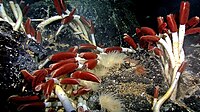
Photo from wikipedia
Microbial symbionts enable many phytophagous insects to specialize on plant-based diets through a range of metabolic services. Pollen comprises one-plant tissue consumed by such herbivores. While rich in lipids and… Click to show full abstract
Microbial symbionts enable many phytophagous insects to specialize on plant-based diets through a range of metabolic services. Pollen comprises one-plant tissue consumed by such herbivores. While rich in lipids and proteins, its nutrient content is often imbalanced and difficult-to-access due to a digestibly recalcitrant cell wall. Pollen quality can be further degraded by harmful allelochemicals. To identify microbes that may aid in palynivory, we performed cDNA-based 16S rRNA metabarcoding on three related pollen beetles (Nitidulidae: Meligethinae) exhibiting different dietary breadths: Brassicogethes aeneus, B. matronalis, and Meligethes atratus. Nine bacterial symbionts (i.e., 97% OTUs) exhibited high metabolic activity during active feeding. Subsequent PCR surveys revealed varying prevalence of those from three Rickettsialles genera-Lariskella, Rickettsia, and Wolbachia-within beetle populations. Our findings lay the groundwork for future studies on the influence of phylogeny and diet on palynivorous insect microbiomes, and roles of symbionts in the use of challenging diets.
Journal Title: Microbial ecology
Year Published: 2022
Link to full text (if available)
Share on Social Media: Sign Up to like & get
recommendations!